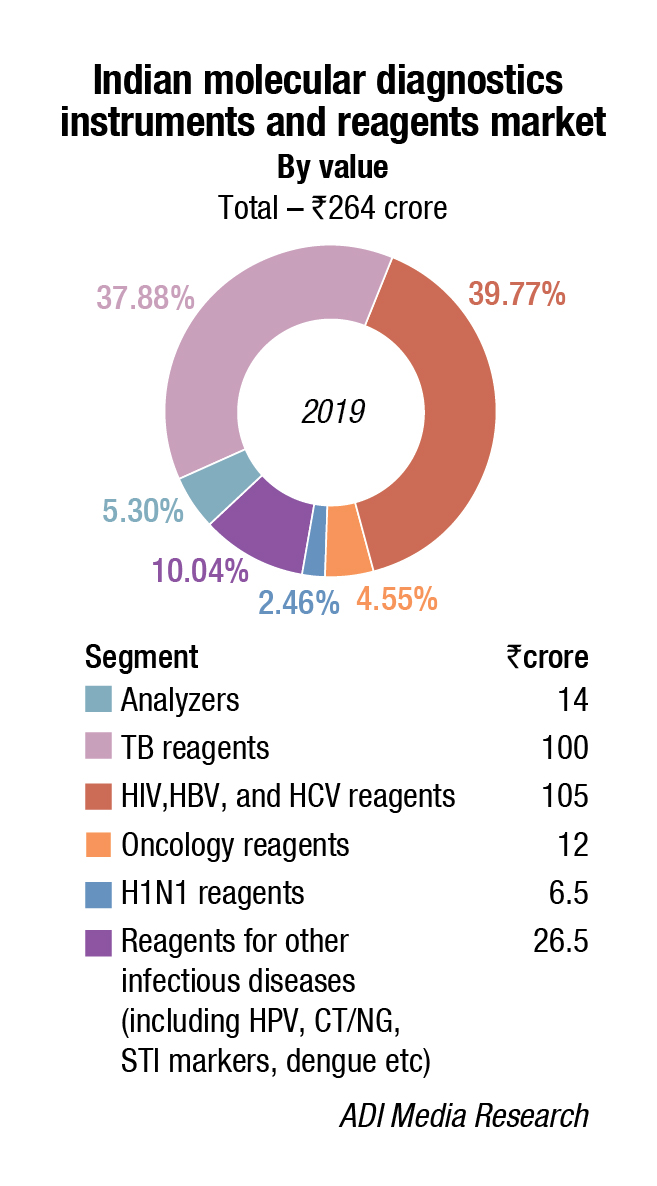IVD
COVID-19 MDx testing: Some harsh lessons learnt

Granting an EUA was perhaps essential at that point, but it brought to the fore weaknesses inherent in the system. As the coronavirus wildfire raged across the world, it was a risk the FDA needed to take.
 On February 4, 2020, the US Secretary of Health and Human Services declared that emergency use of diagnostics for SARS-CoV-2 was justified, triggering the Food and Drug Administration (FDA) to grant an emergency use authorization (EUA) for a device if it reasonably believes that it may be effective, rather than waiting to grant full approval when it has reasonable assurance that the device is safe and effective. This mechanism expedites access to accurate diagnostic tests during emergencies, when information gaps and false results may adversely affect patient care and public health decision making.
On February 4, 2020, the US Secretary of Health and Human Services declared that emergency use of diagnostics for SARS-CoV-2 was justified, triggering the Food and Drug Administration (FDA) to grant an emergency use authorization (EUA) for a device if it reasonably believes that it may be effective, rather than waiting to grant full approval when it has reasonable assurance that the device is safe and effective. This mechanism expedites access to accurate diagnostic tests during emergencies, when information gaps and false results may adversely affect patient care and public health decision making.
This was a major turning point for the molecular diagnostics industry.
The EUA process enabled molecular diagnostic tests to be developed, validated, and deployed within weeks rather than several months to over a year, as traditionally required. To streamline submissions, the agency developed an EUA template with recommendations on validating a molecular diagnostic test for SARS-CoV-2 and outlined the required information. By July 31, the FDA had authorized 163 COVID-19 diagnostic tests.
The EUA template also streamlined submission paperwork. A typical submission seeking full FDA approval for a test is about 1000 pages for laboratories and about 2000 pages for commercial manufacturers that distribute tests. The template reduced commercial manufacturers’ EUA submissions to 100 to 200 pages and laboratory submissions to about 40 pages, of which only about half were generated solely to meet FDA requirements, and most of those consisted of data rather than text. For a COVID-19 EUA, the FDA initially permitted test performance to be demonstrated by a computer analysis indicating the percentage of identity matches with publicly available SARS-CoV-2 sequences that could be detected by the proposed molecular assay and cross-reactivity with other respiratory pathogens and by testing contrived samples.
 Dr Jyotsana Mehta Nagpal
Dr Jyotsana Mehta NagpalSenior Research Associate/ Pool Scientist, Department of Bio and Nanotechnology, GJUST
“The direct specimen testing has witnessed major technology explosions in two directions recently, namely, direct-specimen rapid amplification and detection systems and NextGen sequencing platforms. The enhanced research and market orientation toward these technologies for disease diagnosis in direct specimen is attributed to their high speed, sensitivity, and broader detection in laboratory diagnosis.”
Although some COVID-19 test laboratories and kit developers had experience with previous emergencies, some developers and healthcare professionals were unfamiliar with the EUA process, which created misunderstandings and confusion. During the week of February 24, several laboratory groups sought permission to use laboratory-developed tests (LDTs) for patient care without obtaining an EUA. They cited unmet needs due to challenges with the rollout of the test from the Centers for Disease Control and Prevention (CDC) and the lack of alternative tests. Some labs suggested that they would not pursue test development, believing that EUA validation was too burdensome; others were unaware that the EUA pathway was available.
Recognizing the continued need for rapid expansion of testing capabilities, the FDA issued a policy on February 29 indicating that it would not enforce certain requirements for qualified laboratories that had commenced testing after validating a test, provided that the lab notified the FDA of its intention to test patient samples and submitted the validation data in an EUA request within 15 business days. This put labs developing their own COVID-19 tests on the honor system and prioritized early access over independent confirmation of accuracy. Although this approach resulted in earlier test availability, the EUA’s less-rigorous evidence standard, coupled with delayed FDA review, allowed the use of several LDTs that ultimately proved to have performance problems or to be poorly validated.
The process also revealed that some clinicians have a limited understanding of test performance. No test is 100 percent accurate, and performance can vary within populations. COVID-19 diagnostic tests may be less accurate in asymptomatic or low-risk populations and in persons who shed little virus or are early or late in the course of illness. Even if a test were 98 percent sensitive and 99 percent specific, it would still produce a false negative result in 2 of every 100 people infected. If clinicians test 5 million people daily and only 1 percent of them have COVID-19, a total of 1000 positive cases will be missed, which increases the risk of spread, and another 49,500 people will receive false positive results. False positive results can be burdensome to public health officials who are tasked with contact tracing and other public health activities, and many people may be unnecessarily quarantined. An understanding of the positive and negative predictive value of a test should be factored into clinical decision making and patient counseling. To mitigate the impact of false results, all COVID-19 tests authorized to date have been made available only by prescription, so that clinicians can interpret results for patients. However, several nonprescription tests are currently under development.
One of the lessons to be learned are thus not only to take scientifically‐founded pandemic predictions seriously into account in policy elaboration, but also to streamline and institute changes in healthcare systems that impose an evolutionary trajectory that increases coherence, efficiency and preparedness, and the necessary mechanisms to maintain these as new exigencies arise.
Second, when a public health threat warrants large-scale testing, it would be more effective to authorize a small number of well-designed, well-developed, and validated tests run on common high-throughput platforms, followed by a few point-of-care tests, all of which are manufactured in large quantities, than to simultaneously develop and authorize scores of diagnostics. Such diffuse efforts are an inefficient use of resources.
Third, industry need common approaches to validating test design and performance, regardless of whether there is an emergency. Experience with COVID-19 highlights the need for a common legislative framework to ensure that all clinical tests are accurate and reliable.
Fourth, the clinical community should understand test performance and how to use that information in patient care. Tests should be accompanied by clear, standardized, comprehensible information on performance for clinicians and patients. Training and continuing education can enhance physicians’ understanding of test performance, selection, interpretation, and clinical usefulness.
All in all
In conclusion, given the global spread and scale of COVID-19 infections, the diagnostic ecosystem has encountered various bottlenecks. In spite of these challenges, various diagnostic tools will continue to play a critical and complementary role in the management of various stages of the COVID-19 pandemic.











